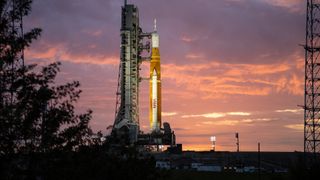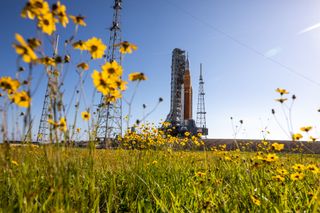Artemis 1 moon mission readies for crucial test for future crewed flights
The first Artemis mission blasts off no earlier than Aug. 29 to certify the Space Launch System and Orion spacecraft for astronauts.

It's nearly go time for NASA's ambitious Artemis moon program.
The debut effort, Artemis 1, will launch no earlier than Aug. 29 filled with sensors, mannequins and other simulations of the astronauts that the rocket and spacecraft will be tasked to bear in future missions.
NASA officials framed this mission as critical to get the Space Launch System megarocket and Orion spacecraft ready for even more ambitious human efforts, while collecting all the science possible with cubesats, a "Moonikin" mannequin and other experiments.
SLS is untested in space and Orion will launch on its second-ever flight, so administrator Bill Nelson told reporters what firsts that the system will endure on a roughly 40-day mission meant to be even harder than what humans would face.
"Orion will venture farther than any spacecraft built for humans has ever flown," he said in a livestreamed press conference Wednesday (Aug. 3). "It will be on a mission of over a million miles [1.6 million kilometers] to the moon and back, in all kinds of orbits around the moon testing the spacecraft ... then after its long flight test, Orion will come home faster and hotter than any spacecraft has before."
Getting through the tests is a requirement for NASA to proceed with its first crewed flight of the program, a moon-circling effort called Artemis 2, in 2024. The first landing is then expected with Artemis 3, with SpaceX's Starship bearing the astronauts to the surface later in the 2020s.
Related: NASA's Artemis 1 moon mission: Live updates
More: NASA's Artemis 1 moon mission explained in photos
Get the Space.com Newsletter
Breaking space news, the latest updates on rocket launches, skywatching events and more!
The mission has three main priorities: to demonstrate Orion can re-enter the spacecraft from a lunar orbit, to make sure the vehicle works in a "flight environment" (meaning from launch pad to splashdown), and to complete a safe retrieval by recovery officials following splashdown, NASA's Mike Sarafin said.
A lesser fourth priority will be to meet various "payload objectives," added Sarafin, who is Artemis 1 mission manager. These will include performing outreach activities, like "Orion taking selfies down the solar array wings of itself in the foreground and the moon in the background."
Three mannequins will be assessing the radiation environment and stresses of spaceflight against what humans are expected to endure, while 10 ridealong cubesats will fulfill further payload objectives, added Bhavya Lal, associate administrator for technology, policy, and strategy at NASA's headquarters.
"The cubesats will be testing innovative propulsion technologies, studying space weather, analyzing the effects of radiation on living organisms — one of my favorite experiments — and providing high resolution imagery of the Earth and moon," Lal said. "Artemis 1 provides a rare opportunity for these small experiments to reach deep space destinations."

SLS is undergoing maintenance and upgrades in support of the Artemis 1 mission timeline, following a wet dress rehearsal test earlier this year that passed NASA certification. SLS, however, encountered several technical issues that are being addressed prior to rolling the stacked rocket back to the pad.
Work is ongoing and still on track to support the Aug. 29 flight date, Charlie Blackwell-Thompson, Artemis 1 launch director at NASA's Kennedy Space Center, said in the briefing, citing several hardware, software and training activities teams are undertaking to get the massive rocket and its support crew ready for launch.
"One of our significant test activities that's upcoming is the flight safety system or the flight termination system test, which is scheduled to begin next week," Blackwell-Thompson said. "Other than that the booster work is pretty much complete."
Related: How NASA's Artemis moon landing with astronauts works
Mission managers will be interested to see how SLS performs in flight, said program manager John Honeycutt at NASA's Marshall Space Flight Center, including the pressures in the hydrogen and oxygen tanks, how well the auxiliary power units power the hydraulic system to maintain pressure, and the timing of rocket staging and burns.
"I have a high level of confidence that we will be able to safely send humans into deep space," Honeycutt said, noting that components have been tested individually, in groups and in the wet dress rehearsal. "This test flight will be one that provides us a tremendous amount of data, and I expect we're going to learn a lot," he added.
Speaking to the overall Artemis 1 profile, Sarafin emphasized that NASA would be "go" for testing to failures that would not be accepted in future human missions, to see what the system limits are.
"We are trying to buy down risk for crewed flight, so we're willing to take more risk on an uncrewed test flight," he said, framing the opportunity as a "lean forward" moment for NASA to get the system ready for humans the next time around.
Follow Elizabeth Howell on Twitter @howellspace. Follow us on Twitter @Spacedotcom and on Facebook.
Join our Space Forums to keep talking space on the latest missions, night sky and more! And if you have a news tip, correction or comment, let us know at: community@space.com.

Elizabeth Howell (she/her), Ph.D., is a staff writer in the spaceflight channel since 2022 covering diversity, education and gaming as well. She was contributing writer for Space.com for 10 years before joining full-time. Elizabeth's reporting includes multiple exclusives with the White House and Office of the Vice-President of the United States, an exclusive conversation with aspiring space tourist (and NSYNC bassist) Lance Bass, speaking several times with the International Space Station, witnessing five human spaceflight launches on two continents, flying parabolic, working inside a spacesuit, and participating in a simulated Mars mission. Her latest book, "Why Am I Taller?", is co-written with astronaut Dave Williams. Elizabeth holds a Ph.D. and M.Sc. in Space Studies from the University of North Dakota, a Bachelor of Journalism from Canada's Carleton University and a Bachelor of History from Canada's Athabasca University. Elizabeth is also a post-secondary instructor in communications and science at several institutions since 2015; her experience includes developing and teaching an astronomy course at Canada's Algonquin College (with Indigenous content as well) to more than 1,000 students since 2020. Elizabeth first got interested in space after watching the movie Apollo 13 in 1996, and still wants to be an astronaut someday. Mastodon: https://qoto.org/@howellspace
